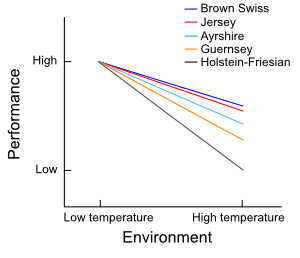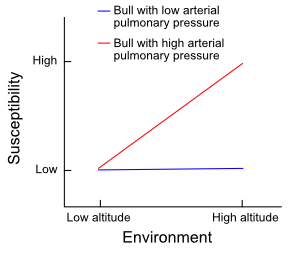Examples of Genotype-Environment Interactions in Animals
G × E interactions can occur between subspecies, breeds, and individuals within a breed. Let’s cover an example from each.
G × E Interactions Between Subspecies of Bos taurus
Genotypes: Bos taurus taurus and Bos taurus indicus
Environments: Temperate and tropical
Bos taurus is the binomial (scientific) name for cattle. There are two subspecies of cattle: Bos taurus taurus (temperate cattle, eg the Angus and Hereford breeds) and Bos taurus indicus (tropical cattle, eg the Brahman and Afrikaner breeds). Photos of the many breeds within each subspecies can be found here.
The Bos taurus indicus subspecies is genetically adapted for tick resistance and extremes in temperature and humidity. The Bos taurus taurus subspecies is not, but is genetically adapted to cooler regions, and fattens readily on forage in preparation for cold winters.
The temperate subspecies performs better in temperate environments than the tropical subspecies, but the tropical one still performs well. In tropical environments however, the tropical subspecies outperforms the temperate one, though the heat, humidity and parasites are stressful conditions for both groups.
We could graph this interaction like this:

© Optimate Group Pty Ltd
Note the reranking that occurs too.
G × E Interactions Between Breeds
Genotypes: Brown Swiss, Jersey, Ayrshire, Guernsey and Holstein-Friesian dairy cow breeds
Environments: High and low temperatures
High temperatures are well-known in the dairy industry to affect milk production. Australia has both temperate and tropical dairy breeds, but the temperate European breeds predominate in the industry. Summers in Australian temperate regions are hotter on average then Europe’s, so let us consider summer temperature variation in Australia as our E.
Of the popular temperate breeds in Australia, the Brown Swiss and Jersey cope best with heat stress, followed by the Ayrshire and the Guernsey, with the Holstein-Friesian coping least well of all. [1]
Please note that the following is not based on real data and is for illustrative purposes only.
We might graph this interaction like this:

© Optimate Group Pty Ltd
G × E Interactions Between Individuals Within a Breed
Genotypes: High pulmonary arterial pressure and low pulmonary arterial pressure
Environments: Altitude above and below 1.5 km (5,000 ft)
Brisket disease, or high mountain disease, affects cattle at altitudes above 1,500 m (5,000 ft) and has major economic costs in the USA.
The low oxygen content at high altitude causes the arterial walls in the lungs of susceptible animals to thicken, which decreases the diameter of, and increases blood pressure in, the pulmonary artery (the artery that carries deoxygenated blood from the right ventricle of the heart to the lungs). The heart has to work harder to pump this blood to the lungs, resulting in the right ventricle enlarging. Eventually the right ventricle becomes so enlarged that it cannot contract any more. Fluid may leak out through the blood vessels and into the brisket and up into the neck and jaw, and/or across into the belly. The animal is lethargic and eventually dies from lack of blood flow to vital organs. Alternatively the animal dies more quickly from heart failure when the buildup of pressure becomes so great that the right ventricle’s valves blow out.
The disease can be selected against by only using bulls with low pulmonary arterial pressure, which is a reliable and heritable measure against the disease.
Because the disease only manifests at high altitudes, we might graph this G × E interaction like this:

© Optimate Group Pty Ltd
The next post will cover how knowledge of G × E interactions can help develop suitable breeding objectives.
Reference:
- Dairy Australia Cool Cows. 2016. Dairy Cattle Herd Susceptibility. Retrieved 26th February, 2018.
Leave a comment